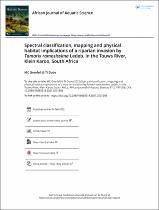| dc.contributor.author | Grenfell, Michael | |
| dc.contributor.author | Dube, Timothy | |
| dc.date.accessioned | 2023-06-15T09:47:10Z | |
| dc.date.available | 2023-06-15T09:47:10Z | |
| dc.date.issued | 2022 | |
| dc.identifier.citation | Grenfell, M., & Dube, T. (2022). Spectral classification, mapping and physical habitat implications of a riparian invasion by Tamarix ramosissima Ledeb. in the Touws River, Klein Karoo, South Africa. African Journal of Aquatic Science, 47(2): 197–206. https://doi.org/10.2989/16085914.2021.2001308 | en_US |
| dc.identifier.issn | 1727-9364 | |
| dc.identifier.uri | https://doi.org/10.2989/16085914.2021.2001308 | |
| dc.identifier.uri | http://hdl.handle.net/10566/9095 | |
| dc.description.abstract | This paper investigates the invasion of a reach of the Touws River by the deciduous alien tree Tamarix ramosissima Ledeb. (Pink Tamarisk, Saltcedar). The objectives of the paper were to investigate the utility of a delta-normalised difference vegetation index (dNDVI) in evaluating the status, pattern and process of invasion, and to evaluate the implications of the invasion for riverscape morphodynamics and physical habitat structure and function. The spectral classification developed had an overall accuracy of 59.89%, omission error of 28.25%, and commission error of 11.86%. The classification of vegetation was used to quantify the aerial extent and pattern of invasion (currently at least 65.50% of the valley floor vegetation cover). Field observations and existing knowledge of seed dispersal mechanisms and germination constraints of the invasive tree were compared with those of the indigenous sweet thorn Vachellia karroo, to provide insight into invasion patterns and processes within the reach. The linear channel-flanking distribution of the invasion has the potential to alter reach hydrology and morphodynamics, which are key building blocks of physical habitat structure and function. The spectral classification approach demonstrated is relatively simple, has a strong biophysical basis in that it exploits a known, predictable and observable seasonal vegetation response that produces a clear spectral signature, and can be applied to long reaches of rivers impacted by alien vegetation invasions | en_US |
| dc.language.iso | en | en_US |
| dc.publisher | Taylor and Francis Group | en_US |
| dc.subject | Agriculture | en_US |
| dc.subject | Technology | en_US |
| dc.subject | Remote sensing | en_US |
| dc.subject | Population studies | en_US |
| dc.subject | Geography | en_US |
| dc.subject | South Africa | en_US |
| dc.title | Spectral classification, mapping and physical habitat implications of a riparian invasion by Tamarix ramosissima Ledeb. in the Touws River, Klein Karoo, South Africa | en_US |
| dc.type | Article | en_US |

